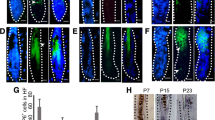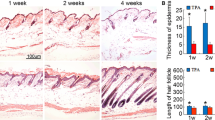Abstract
Hair follicle growth is cyclical, and hair cycle dysfunction can lead to hair follicle-related disorders, including alopecia and hirsutism. The objective was to investigate the influence and underlying mechanism of Krüppel-like factor 4 (KLF4) overexpression on hair follicle growth and development in C57BL/6 mice. To provide a theoretical basis for the biological functions of KLF4 gene in hair follicle development and hair follicle cycle, mice were assigned to three groups: experimental, overexpressing KLF4 (Ad-KLF4); control, expressing green fluorescent protein (Ad-NC); and blank, no treatment. Fur was removed from the dorsal surface, and the mice were intradermally injected with 25 μL 1 × 1010 PFU/mL adenovirus vector (Ad-KLF4 or Ad-NC) at three points. Samples were collected for molecular biological and histological analysis. It was found that mRNA and protein levels of Wnt pathway-associated factors β-catenin, LEF1, hair follicle cell proliferation-related factor Ki67, and hair follicle inner caledrin marker AE15 were all significantly greater in the Ad-NC and blank groups than in Ad-KLF4 mice (P < 0.01). These findings were confirmed by immunohistochemical analysis. Hair growth was monitored photographically for 14 days, showing an absence of growth in the injected region of the KLF4-overexpressing mice in contrast to non-overexpressing areas where hair growth was normal. HE staining showed that hair follicles in the blank and Ad-NC mice were normal, while those in the KLF4-overexpressing areas remained in telogen or early anagen with spherical dermal papillae situated at the edge of the dermis and subcutaneous tissue without an inner heel sheath. In conclusion, it was found that KLF4 downregulated key Wnt/β-catenin-associated factors during follicular regeneration in mice, reducing both follicular development and growth.






Similar content being viewed by others
Data availability
The data that support the findings of this study are available from the corresponding author upon reasonable request.
Change history
23 August 2023
Editorial responsibility section was missed before publication.
References
Evans PM, Chen X, Zhang W et al (2010) KLF4 interacts with beta-catenin/ TCF4 and blocks p300/ CBP recruitment by beta-catenin [J]. Mol Cell Biol 30(2):372–381
Feng ZQ, Sun YF, Song YP et al (2021) Research Progress on the Correlation between Wnt/β-catenin Signaling Pathway and Hair Follicle [J]. Chin J Anim Sci 57(06):88–95
Hawkshaw NJ (2020) Deciphering the molecular morphology of the human hair cycle: Wnt signalling during the telogen-anagen transformation [J]. Br J Dermatol 182(5):1184–1193
He X, Xue Y, Wang XZ et al (2019) KLF4 inhibits Wnt/β-catenin signaling pathway and regulates chondrocyte proliferation [J]. Chin J Integr Tradit West Med 28(34):3773–3776
Houschyar KS, Borrelli M, Tapking C et al (2020) Molecular mechanisms of hair growth and regeneration: current understanding and novel paradigms [J]. Dermatology 236(4):1–10
Kandyba E, Kobielak K (2014) Wnt7b is an important intrinsic regulator of hair follicle stem cell homeostasis and hair follicle cycling [J]. Stem Cells 32(4):886–901
Kandyba E, Leung Y, Chen YB et al (2013) Competitive balance of intrabulge BMP/Wnt signaling reveals a robust gene network ruling stem cell homeostasis and cyclic activation [J]. Proc Natl Acad Sci USA 110(4):1351–1356
Li J, Zheng H, Yu F et al (2012) Deficiency of the Kruppel-like factor KLF4 correlates with increased cell proliferation and enhanced skin tumorigenesis [J]. Carcinogenesis 6:1239–1246
Li YH, Zhang K, Yang K et al (2013) Adenovirus-mediated Wnt10b overexpression induces hair follicle regeneration [J]. J Invest Dermatol 133(1):42–48
Liu GY, Cheng GM, Zhang YC et al (2021) Pyridoxine regulates hair follicle development via the PI3K/Akt, Wnt and Notch signalling pathways in rex rabbits [J]. Anim Nutr 7(4):1162–1172
Nicolas FO, Martin MT (2020) When the search for stemness genes meets the skin substitute bioengineering field: KLF4 transcription factor under the light [J]. Cells 9(10):2188–2188
Qin H, Chen YX, Wang S et al (2022) The role of KLF4 in melanogenesis and homeostasis in sheep melanocytes [J]. Acta Histochem 124(1):151839
Rishikaysh P, Dev K, Diaz D et al (2014) Signaling involved in hair follicle morphogenesis and development [J]. Int J Mol Sci 15(1):1647–1670
Segre JA, Bauer C, Fuchs E et al (1999) KLF4 is a transcription factor required for establishing the barrier function of the skin [J]. Nat Genet 22(4):356–360
Sellak H, Wu S, Lincoln TM (2012) KLF4 and SOX9 transcription factors antagonize beta-catenin and inhibit TCF-activity in cancer cells [J]. Biochim Biophys Acta 1823(10):1666–1675
Sen G, Boxer L, Webster D et al (2012) ZNF750 is a p63 target gene that induces KLF4 to drive terminal epidermal differentiation [J]. Dev Cell 22(3):669–677
Stone CD, Chen ZY, Tseng CC (2002) Gut-enriched Kruppel-like factor regulates colonic cell growth through APC/ beta-catenin pathway [J]. FEBS Lett 530(1–3):147–152
Sunkara RR, Mehta D, Sarate RM et al (2022) BMP-AKT-GSK3β signalling restores hair follicle stem cells decrease associated with loss of Sfrp1 [J]. Stem Cells 6(11):sxac041
Tetreault MP, Weinblatt D, Shaverdashvili K et al (2016) KLF4 transcriptionally activates non-canonical WNT5A to control epithelial stratification [J]. Sci Rep 6(1):26130
Wang Q, Xu J, Chen Y et al (2019) KLF4 overexpression decreases the viability, invasion and migration of papillary thyroid cancer cells. Exp Ther Med 18(5):3493–3501
Wu Z, Wang Y, Han W et al (2020) EDA and EDAR expression at different stages of hair follicle development in cashmere goats and effects on expression of related genes [J]. Arch Anim Breed 63(2):461–470
Xing YZ, Wang RM, Yang K et al (2013) Adenovirus-mediated Wnt5a expression inhibits the telogen-to-anagen transition of hair follicles in mice [J]. Int J Med Sci 10(7):908–914
Zhang W, Chen X, Kato Y et al (2006) Novel cross talk of Kruppel-like factor 4 and beta-catenin regulates normal intestinal homeostasis and tumor repression [J]. Mol Cell Biol 26(6):205–2064
Zhang M, Zhu XW, Wang XE et al (2010) The experimental study of C57BL/6 mouse skin hair follicle developmen [J]. Chin J Anat 28(01):74–77
Funding
This work was supported by grants from National Natural Science Foundation of China (No. 31872532, No. 31272628) and Research Innovation of Veterinary Medicine College of Shanxi Agricultural University (No. DY-M005).
Author information
Authors and Affiliations
Contributions
Hongyu Han, Hong Qin, Quanhai Pang: Conception and design.
Hongyu Han, Hong Qin, Lijun Zhao: Development of methodology.
Hongyu Han, Lijun Zhao, Tong Shen: Acquisition of data.
Hongyu Han, Yu Yang: Analysis and interpretation of data.
Hongyu Han, Quanhai Pang: Writing, review, and/or revision of the manuscript.
Corresponding author
Ethics declarations
Competing interests
The authors declare no competing interests.
Ethics approval
The animal experiments in this study were reviewed by the Animal Ethics Committee of Shanxi Agricultural University, and the relevant experimental animals met the ethical requirements of animal experiments.
Conflict of interest
The authors declare no competing interests.
Additional information
Communicated by Tamara Franz-Odendaal
Publisher's note
Springer Nature remains neutral with regard to jurisdictional claims in published maps and institutional affiliations.
Supplementary Information
Below is the link to the electronic supplementary material.
Rights and permissions
Springer Nature or its licensor (e.g. a society or other partner) holds exclusive rights to this article under a publishing agreement with the author(s) or other rightsholder(s); author self-archiving of the accepted manuscript version of this article is solely governed by the terms of such publishing agreement and applicable law.
About this article
Cite this article
Han, H., Qin, H., Yang, Y. et al. Effect of overexpression of KLF4 on the growth and development of hair follicles in mice. Dev Genes Evol 233, 137–145 (2023). https://doi.org/10.1007/s00427-023-00708-8
Received:
Accepted:
Published:
Issue Date:
DOI: https://doi.org/10.1007/s00427-023-00708-8




